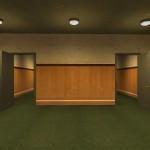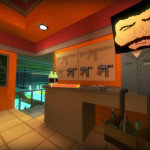Recent years brought us many “artsy” narrative-driven games with varying degrees of interactivity. But as the genre matures, I feel the gameplay is increasingly getting in the way of enjoying the games.
Degrees of Interaction

Looking at games we can distinguish many “degrees of interaction” such as controlling the character, triggering world objects, puzzles and item-hunts, shooting monsters or conversing with NPCs. On one end we have Dear Esther and 30 Flights of Loving which practically have none, only allowing you to move forward enjoying the environment and story. Then we have things like Home or The Walking Dead which provide explorable areas and have some light puzzles with item scavenging like the classic point and click adventure games. And all the way on the deep end there’s the likes of Fallout New Vegas or The Witcher with a full blown RPG world, battle systems, numerous characters and so on.
All these games are primarily narrative-driven, trying to tell or build a story of some sort, with “gameplay” being one of the ways of accomplishing that, among environmental aesthetics, newspaper clippings, cutscenes or other clues. But at what point does this gameplay stop contributing, and starts hampering the storytelling?
When gameplay harms the game
Personally, I found Home to be a great example of this problem. It slowly starts feeling tedious with back-and-forth walking, slow text scrolling, and a bit repetitive environments. And the few puzzles, like the electric switches, further stand in the way of, rather than contribute to, uncovering the story. This does not encourage me to replay a game which begs to be re-played. I really want to know what was on the tape but just can’t be bothered to slog through the same-y rooms trying to find a video player.
The Walking Dead falls in this category as well. While I enjoyed the fast moving cut-sceny bits that occasionally force you to make split-second decisions, I disliked the open free-roam portions. They largely boiled down to interacting with every single thing in every way possible until I finally stumbled upon the one particular solution the developers had in mind (taking me back to the old point & click days). I want to know what happened to Clementine, not spend half an hour clicking around randomly until SomethingHappens™ !
When gameplay is just enough

A great example of gameplay being just right is Stanley’s Parable, a mod for Half Life 2 about the narrative in video games (how meta!) Without spoiling too much, it only really lets you move forward, occasionally letting you chose between two doors or corridors. The few buttons you need to press are directly tied to the game’s message and underlying theme. There are no puzzle’s for puzzle’s sake, or arbitrary item hunts to extend play time. In a nutshell, every bit of “interaction” serves a clear purpose, and there is no more of it than is necessary.
I also applaud 30 Flights of Loving for basically skipping on the whole “game” part of the game and just focusing on narrative. In contrast with it’s predecessor, Gravity Bones, which features irritating puzzle sections that could result in death. You should never have to die and re-try in a narrative-based game, it serves no purpose and breaks the flow.
So why not make movies?
Andrzej Sapkowski, a Polish author of the original Wiedzmin (Witcher) books the RPG games have been based on, recently told Eurogamer: “A story can only be contained in a book.” So if the games above are narrative-driven and if less gameplay is often better, wouldn’t these “stories” work just as well in pure book or film form?
Well, no.

The “interaction” fundamentally changes how we “perceive” the medium, affecting our experience, at least the first time. More importantly, many of these games use interaction to let you, the player, decide how much of the world and story you “experience,” either quickly pushing forward or inspecting every nook and cranny. This can dramatically affect the playthrough and Home, despite my complaints, is a great example of exactly that. The wonderful Radiator Design Blog explores how game space and environments tell stories, so I highly recommend you check it out.
Lastly, let’s not forget that many outcomes in narrative games are dependent on the choices you make, so a linear film would completely destroy the whole point of playing them. Or you can just watch many numerous “Let’s Play” videos on youtube of these games and tell me it’s the same thing as actually playing them.
Influence on my game
This topic fascinates me since it’s directly relevant to my upcoming game, Postmortem, which also falls in a narrative/exploratory genre. I have been on the fence about how many degrees of interaction I want to include. In my original designs, you had to scour for clues, search for hidden keys, sneak behind people’s backs or solve puzzles to learn about the world. I even considered a pick-pocketing and light-based sneaking mechanic.
But as I finalized the alpha version focusing mainly on simpler exploration, and having been annoyed with Home and The Walking Dead’s gameplay getting in the way, I am no longer sure if more “gamey” elements are the right direction for Postmortem.
Both “versions” would have very different flavors to them, but in all honesty I believe both could be interesting in their own right. Perhaps creating those two “alternates” side by side to directly see the impact of gameplay on the experience would be an interesting experiment of its own..?
Addendund – “But if you can’t lose, it’s not a game!”
All of this has, of course, led to a heated debate among gamers, with many criticizing the above mentioned titles as not really being games. And you know what? So what! Perhaps they are a new sub-genre of games? Or perhaps they are a whole new artform borrowing a bit from film, a bit from games, but not quite being either. Whatever you label it, this new interactive-narrative thing exists, and given its growing popularity, is not going away. So stop bickering about labels and start enjoying it already!